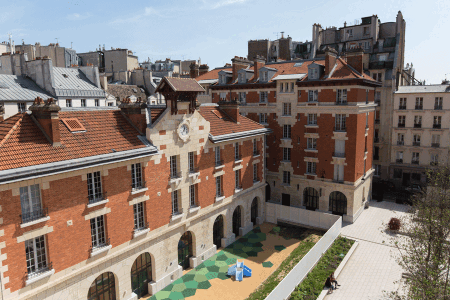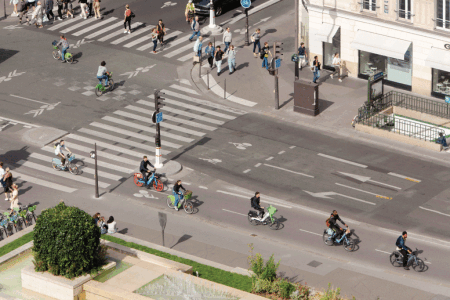Paris mayor Anne Hidalgo, known for reinventing Paris as a 15-minute city, to receive the prestigious ULI Prize for Visionaries in Urban Development.
Known for progressive leadership in addressing climate change and reducing vehicle traffic in Paris, Hidalgo’s influence reaches far beyond Paris as she promotes what she is achieving—mixed-use, walkable, cycling, livable, climate-ready communities.
The French-Spanish politician was elected mayor in 2014, after serving as First Deputy Mayor of Paris under Bertrand Delanoë (2001–2014), and holding the title of Paris City Councillor from the 15th arrondissement since March 9, 2001. On January 22, 2016, she was chosen to serve as the first vice president of the Metropolis of Greater Paris. That body, the Metropolitan Council, was created in January 2016 as a community of 131 municipalities serving 7.2 million inhabitants.
In addition to her global leadership of cities fighting climate change, Hidalgo has been a champion of women and has received accolades for her achievements, including being named among Time magazine’s 100 Most Influential People in 2020.
Hidalgo was born in San Fernando, near the city of Cádiz, in Andalusia, Spain. In 1961 her parents moved to France as economic immigrants and settled in Lyon with their two daughters. Hidalgo became a French citizen at age 14 and has dual French-Spanish nationality. She is fluent in Spanish and French. She is the mother of three children.
Urban Land: Your nomination [from] the ULI Prize for Visionaries in Urban Development jury stated that you are able to “craft big picture goals and vision for the city of tomorrow, yet at the same time understand that we stand the best chance of transformative urban change if we start with the human perspective of what makes a great urban experience.” How were you able to support these big-picture goals with tactical, tangible initiatives?
Anne Hidalgo: Thank you very much and it is such an honor to receive the ULI Prize. This is undoubtedly one of the greatest prizes you can receive when you are a mayor, a prize for vision.
In 2014, when I was elected mayor, one of the great challenges for Paris was [its risk of becoming] a museum city, [one] which loses its creativity and is not engaged in the great [hurdles] of the century, such as climate change. At the start of my first mandate, I was first confronted with attacks—the Paris [terrorist] attacks in 2015—which also posed another question: that of our ability to live together in an open city, a city in which all nationalities rub shoulders, and in which there are also many people with immigrant backgrounds. And so, both the climate question, and also the social question were the two subjects that I tried to keep in mind when I decided to transform the city so that it adapts and responds to such challenges. At the end, it is about enabling Parisians to have the most pleasant life possible.
So, I took action, of course, on mobility, air pollution, and the reduction of traffic, because Paris was a city that was still extremely polluted, and pollution kills. Particularly because of car traffic, we had to redesign, to think about all the arrangements and, in particular, think about the place for pedestrians and bicycles.
I relied on my team of ecologists, humanists, and liberals, and I consulted scientists, economic actors, NGOs, and citizens, to move forward in these two directions. It was a real struggle because I was going in an opposite direction for our city. And I still remember how difficult it was to be able to transform an urban highway that ran alongside the Seine into a walking space. We also struggle to promote social housing, housing for poor or middle-class or working-class populations, in neighborhoods that were the wealthiest neighborhoods in the capital.
But I believe that the work that we have done—and all the citizen participation—has allowed us to move forward. And today, thanks to the Olympic and Paralympic push, we are accelerating. I believe that Paris is really on the trajectory of ecological transition, of changing mobility.
UL: As part of your re-election campaign in 2020, you unveiled a plan for a “15-minute city,” a term that originated with Paris-based urbanist Carlos Moreno and used to describe an idyllic neighborhood where everything a person needs to live, work, and play is within easy reach. Your support of this ideal has also sparked a global movement. What needs to happen next in terms of city adoption for the world to achieve carbon reduction and net zero goals?
Anne Hidalgo: Indeed, this idea of the 15-minute city that was developed by Carlos Moreno, and that has been translated into urban policies based on the idea that Paris should be the best city, a city to live in. A city that faces great global challenges. But this is a city with inhabitants who seek, and deserve, to live in the best environment, with good public and private services, access to culture, good schools, and promenades and parks close to their home. This is an idea which, I believe, allows us to combine both climate and social challenges.
Some examples of what we have done since 2020 are part of this idea of being very committed to the climate issue and applying the 15-minute scheme in order to improve people’s lives. For example, “Streets to Schools,” because it matters, too: How can children feel better in the city, more secure? How can parents let go of their hands in the street? Well, we have closed the streets to cars near schools, planted trees, opened spaces, and today Parisians are asking me to open many more “Streets to Schools.”
Another example: We transformed a very large building that was a public office building [belonging] to the city of Paris, and we launched a project in which private developers—and also association and social housing developers—responded. And this place is, today, near the Paris city hall, [and] therefore on the banks of the Seine. The building is called [La Félicité Paris Sully-Morland], and in this building are [about 160] social housing units for families who live on the banks of the Seine, at prices that allow them to live in this type of housing. [It also contains] some very, very expensive accommodations for people who will pay very, very dearly for … them. And then, finally, a four- or five-star hotel, and … a youth hostel where you can sleep for 29 euros a night, and then shops, and then a garden.
UL: From 2015 to 2019, you served as chair of C40, and in July this year you were elected as vice chair of the steering committee of C40, a global network of nearly 100 mayors of the world’s leading cities that are united to confront the climate crisis. What are some of the key initiatives that will guide C40 over the next 5–10 years?
Anne Hidalgo: I learned a lot within the C40, precisely by interacting with my fellow mayors …. And then, also the chance to meet great personalities like Mike Bloomberg, for example, who also gave us the means of investigative research to support our municipal policies. I think it’s very important. This network has taught me a lot, and I, of course, continue to work there.
The conviction and the facts are there: Large cities are the main emitters of greenhouse gases. Seventy percent of greenhouse gases are emitted by the world’s major cities. This is where we must find solutions to limit global warming. We have the biggest impact and therefore have the biggest responsibility.
UL: Almost 10 years have passed since the Paris Agreement to fight against climate change. Is the city on track to meet the COP21 targets? Are cities leading the way in the fight against global warming?
Anne Hidalgo: Yes, but we should not forget that C40 represents the 100 largest metropolises in the world. And 75 percent of these cities are almost 10 percent away from [achieving] the COP21 objectives. We have initiated policies, everywhere in our cities, concerning public transport and the reduction of pollution, the decarbonization of the economy of our cities, and the construction of buildings here. And we are conducting research to reduce the impact of construction. So, the cities are complying, whereas the states are not.
UL: Can you talk about the city’s “low-emission zone” and other plans to reduce cars on Paris streets—like the so-called “car-free” zone, slated to take effect in 2024, that will ban motor vehicles from driving through much of Paris’ 1st to 4th arrondissements? Also, what has been the predominant reaction from residents and visitors?
Anne Hidalgo: It is always complicated to change citizens’ habits, particularly in terms of mobility. The good thing for mayors who decided to introduce low-emission zones is that in the hearts of our cities, the public transportation is great—Paris is a city where we have a very high density of public transport—we have a metro station or a bus station less than 10 minutes’ walk all over the city.
Therefore, the issue is not really with the people who already live in the large urban center but with the journeys between the periphery and the center. The first solutions are with public transport—that is to say, offering this possibility of transport, including to people who have longer distances from the periphery to the center, or quite simply going from the periphery to the suburbs.
So, for several years now, we have been working on the “Grand Paris Express.” In the coming years, with the Olympic Games and after, there will be an even larger transport network that will serve the whole of Greater Paris and the Île-de-France region much better.
Then we obviously have to avoid what we call “transit traffic.” People who enter Paris, pass through Paris, do not stop in the city but do create a flow of vehicles and pollution. It explains why these limited traffic zones are extremely important. They allow in the city only those who have something to do in the city with their vehicle to enter. And then there is, of course, a social subject. We need to support the middle and working classes, artisans, and tradespeople, who need their vehicles to commute and to get around; if we do not help them move towards electric or hydrogen vehicles, given the high cost today of these vehicles, then it will not work. We need to help them financially. This change falls more within the competence of the national state. We are pushing for this to be able to make the question become the central issue that accounts for climate and social equity.
UL: What infrastructure improvements, including roads, construction of bike lanes, public transportation, and/or building retrofits/conversions—among any other improvements—were required to reinvent Paris as a 15-minute city? How has this been funded?
Anne Hidalgo: The transformation of our infrastructure, for example, towards cycling, has allowed us to reduce pollution by 40 percent. This is a concrete, measurable result that we have today. I can also tell you, for example, that, in terms of housing construction, the city of Paris today has 25 percent social housing [a.k.a., affordable housing], which makes our city a socially mixed city.
UL: Next year you will welcome the entire world at the Olympic Games. Among many other projects, you have promised to make the Seine swimmable. Are you going to achieve this? More generally, how have the Olympic Games been useful for you as mayor?
Anne Hidalgo: I love sport. Now the Olympics Games, for me as mayor, it was mainly an opportunity to accelerate the transformation of the city. I really wanted the ecological transformation to be accelerated, and to be at the heart of the games. It’s important because, in a country like France, often the different levels—the authorities, the politicians—everyone argues and, as a result, it sometimes delays projects.
One of the big challenges is swimming in the Seine. We all had to come together for one goal. And yes, we are going to swim in the Seine for the Olympic and Paralympic games next year. And, after the games, there will be three swimming sites in the Seine that will be in extraordinary locations. I will swim next year in July.
UL: You are also leading an ecological transformation of Paris that includes the goal of planting 170,000 trees by the end of 2026, and your proposal to transform the Champs-Elysées by creating several gardens along the famous avenue. What are the benefits you hope to achieve in terms of carbon reduction and health, and what else do you hope to unveil in the future that will be part of this ecological transformation?
Anne Hidalgo: It is very, very important to plant trees. We know, with the [shifts] that are expected, linked to climate change, temperatures in Paris could reach 50 degrees Celsius in summer [within] the next 30 years.
We are in the process of transforming a very famous square, designed by Ricardo Bofill, in the 14th arrondissement of Paris—the Place de Catalogne, which will become an urban forest.
For instance, we are going to plant this winter, starting in November, 40,000 trees.
We are also going to create or enlarge, by 2035, 10 more major parks in Paris to create precisely these breathing spaces and these natural spaces for Parisians.
And after the games, we will have a large park—in fact, 56 hectares [560,000 sq m]— that will be an extraordinary wooded park, planted from the Place du Trocadéro to the Eiffel Tower. These are not utopias. These are projects which are either already being carried out or will be carried out just after the games—such as, for example, the major project from the Trocadéro to the Eiffel Tower.
UL: You are the first woman to hold the office of … mayor [in] Paris, elected by a clear majority in 2014. In 2020, you received a fine of 90 thousand euros from the French national government for naming 11 women, out of 16 positions, to your upper management. There has also been criticism that you are perhaps too much of a feminist. What should other decision-makers understand about your actions if the world is ever to achieve equality?
Anne Hidalgo: Being a woman in this type of position is already a bit disruptive in itself. When a woman is elected mayor of a major city—mayor of Paris—it’s not simply to say to herself, “I’m there. If I’ve succeeded, that’s it!” It is about changing things, and being given such opportunity, well, it gives me a lot of energy.
We must not be afraid to go off the paths that politicians who have more traditional backgrounds usually follow, even if sometimes we are mocked. For instance, considering the place of children in the city is also a way of changing things. It is about making things happen, and maybe maybe being a role model for little girls and telling them they can follow their hearts.
For the detractors, I listen to criticism when it is a way to improve. We don’t succeed at everything. And we sometimes make mistakes. I do not listen to critics when they discard the legitimacy of a woman elected as the head of a city like Paris, just because she carries social and ecological policies.
I really believe that female leadership exists. It’s complicated, because women who are elected to positions of power can be tempted to do like men, to forget that they must also help other, younger women to progress, and [women in power must] also take responsibility. But I think that the biological difference between men and women does not count. What counts are their different life experiences.
Such differences between men and women allow women to bring something very new, and very useful, to politics.
SIBLEY FLEMING is editor in chief of Urban Land.
ULI has also created a leadership guide on Building 15-Minute Communities.










